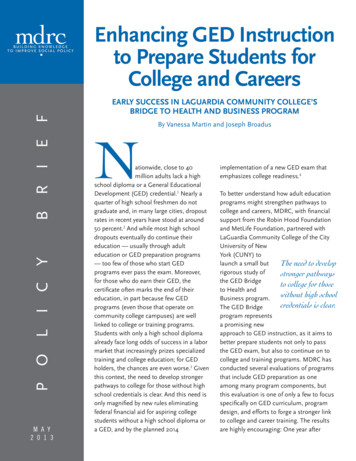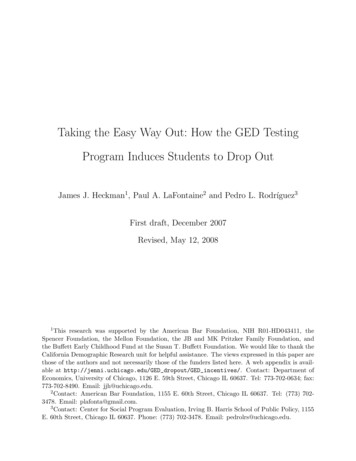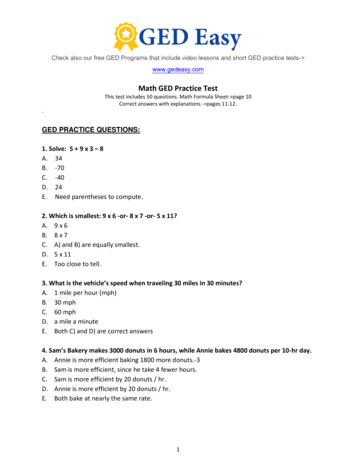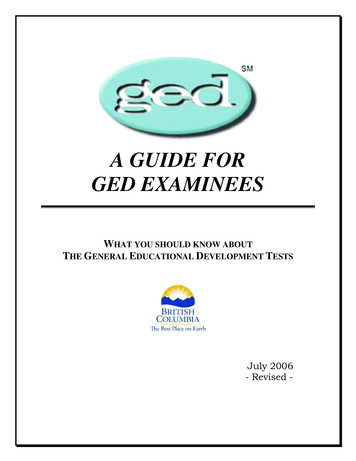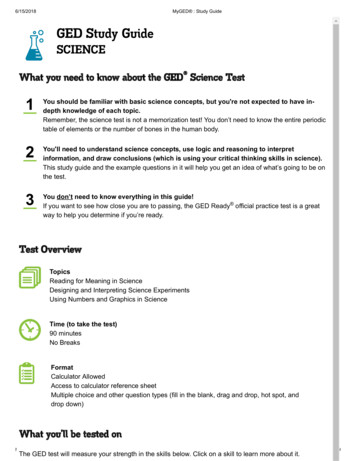
Transcription
6/15/2018MyGED : Study GuideGED Study GuideSCIENCEWhat you need to know about the GED Science Test1You should be familiar with basic science concepts, but you're not expected to have indepth knowledge of each topic.Remember, the science test is not a memorization test! You don’t need to know the entire periodictable of elements or the number of bones in the human body.2You'll need to understand science concepts, use logic and reasoning to interpretinformation, and draw conclusions (which is using your critical thinking skills in science).This study guide and the example questions in it will help you get an idea of what’s going to be onthe test.3You don’t need to know everything in this guide!If you want to see how close you are to passing, the GED Ready official practice test is a greatway to help you determine if you’re ready.Test OverviewTopicsReading for Meaning in ScienceDesigning and Interpreting Science ExperimentsUsing Numbers and Graphics in ScienceTime (to take the test)90 minutesNo BreaksFormatCalculator AllowedAccess to calculator reference sheetMultiple choice and other question types (fill in the blank, drag and drop, hot spot, anddrop down)What you'll be tested /guide/SCIENCE/printThe GED test will measure your strength in the skills below. Click on a skill to learn more about it.1/19
#/study/guide/SCIENCE/printMyGED : Study Guide2/19
6/15/2018MyGED : Study GuideReading for Meaning in Science1Claims and evidence in scienceYou'll be presented with science passages and be asked to:Find evidence that supports a findingMake sense of information that differs between various science sourcesScience readings often discuss theories or draw conclusions from evidence that ispresented. You should be able to read science passages and identify the evidence thatsupports the theory, principle, or conclusion that has been drawn.For example, global climate change is a science topic that is frequently discussed in thenews. Articles about this topic generally present evidence as to how humans either are orare not responsible for the changing climate. It's important for you to be able to readsomething about climate change and identify the evidence that the authors cite to supporttheir conclusions.Example QuestionsClaims and evidence in scienceTwo chemists are designing instant hot and cold packs for a sports medicine supplycompany. Their design uses chemicals that react with water to either heat up or cooldown the water inside the packs. They are investigating the reaction of ammoniumchloride with water to determine whether it is exothermic or endothermic.Chemist A read a study done recently by the National Institute for Standards andTesting, which reported that 27.6 kilojoules of energy are absorbed by 100 grams ofammonium chloride when it is mixed with water. Chemist B measured thetemperature of the water in which the reaction takes place before and after thereaction. The results are displayed in the tudy/guide/SCIENCE/print3/19
6/15/2018MyGED : Study GuideQuestion:Does Chemist B's results support or contradict the evidence reported by Chemist A?You may use the calculator.AChemist B's results supports Chemist A's data because the reactiongains less energy than the water does.BChemist B's results contradicts Chemist A's data because it indicatesthat the reaction gains energy instead of losing it.CChemist B's results contradicts Chemist A's data because it indicatesthat the temperature of the reaction should go up rather than down.DChemist B's results supports Chemist A's data because the lowertemperature of the water indicates that energy is absorbed by tal#/study/guide/SCIENCE/print4/19
6/15/2018MyGED : Study Guide2Science vocabulary, terms, and phrasesYou'll be shown different science passages and visuals and asked to:Understand and explain information from the passagesUnderstand symbols, terms, and phrases in scienceUse scientific words to express science informationScience readings often use special vocabulary and include elements such as charts andgraphs in addition to standard text. You should be able to read and explain what isdiscussed in a science passage including the different text and graphic elements that mightbe included.You'll see questions that use common science symbols, terms, and phrases, such asdegree signs, atomic element symbols, and scientific formulas. You'll also see commonscientific words.For example, a science passage about the causes of earthquakes might include specialgeology terms or concepts like plate tectonics. It might also include maps showingearthquake activity and charts that describe quake intensity in addition to the text provided.You should be able to take all of these elements and understand and describe the keymessages that the passage is trying to communicate.Another example: in the molecular structureCO2 H2O H2CO3you will not need to know that CO2 is carbon dioxide or H2O is water, but you will need tobe familiar with the idea that these are representations of two distinct substances, whichwhen combined ( ), form a new substance ( ) (carbonated water).A third example: understanding the difference between a theory, a hypothesis, and ascientific law will help you determine when you can draw conclusions and when you willneed more information.Example QuestionsScience vocabulary, terms, and phrasesAbout 2.7 billion years ago, the lower atmosphere had almost no oxygen. It was longbefore plants existed to produce oxygen. However, in the upper atmosphere, oxygencan be produced when carbon dioxide is split by sunlight into carbon monoxide andoxygen.Scientists examined 11 ancient micrometeorites, all older than 2.7 billion years old,and discovered that most of them had once been particles of iron mixed with oxygen.In order for that to happen, there had to be almost as much oxygen in the upperatmosphere as there is now. The scientists say that the new information about y/guide/SCIENCE/printupper atmosphere does not change what they know about the lower atmosphere.5/19
6/15/2018MyGED : Study GuideQuestion:Which statement accurately summarizes the passage?AMicrometeorite analysis proves that 2.7 billion years ago, there wasno oxygen in the lower atmosphere or the upper atmosphere.BMicrometeorite analysis proves that 2.7 billion years ago, there wasoxygen in the lower atmosphere but not in the upper atmosphere.CMicrometeorite analysis proves that 2.7 billion years ago, there wasoxygen in the upper atmosphere but not in the lower atmosphere.DMicrometeorite analysis proves that 2.7 billion years ago, there wasoxygen in both the lower atmosphere and the upper al#/study/guide/SCIENCE/print6/19
6/15/2018MyGED : Study GuideDesigning and Interpreting Science Experiments1Science investigationsYou'll be asked to:Design a science investigationIdentify and explain independent and dependent variablesIdentify and improve hypotheses for science investigationsIdentify possible errors in a science investigation and change the design to correctthemIdentify the strengths and weaknesses of different types of science investigationsKey principles of science investigations include using and recording data, developing ahypothesis, setting up experiments, identifying controls and variables, and drawingconclusions. You will be asked to evaluate investigations that may or may not have flaws inone or more of these areas.You'll also evaluate and improve a hypothesis, or make a prediction about the outcome of ascience investigation that can be tested. You will be asked to determine the independentvariables (those that can be changed or controlled in a scientific experiment) anddependent variables (things that are changed by the independent variable).In the passage below, you will see the key principles of science investigations.The lakes in a town have recently begun developing significant amounts of algae which arepreventing people from enjoying recreational activities on them. Environmental scientistsare brought in to determine the origin of the algae. They develop a hypothesis that thephosphorus content of the fertilizers used in nearby parks are stimulating excess algaegrowth. The scientists decide to discontinue the fertilizer at one of the local parks. Theythen measure and record algae growth for four months at the lake near a park wherefertilizer use continues (control group) and the lake near another park where fertilizer hasbeen discontinued (changing the variable of phosphorus fertilizer). After four months, theyobserve that the algae has markedly decreased at the lake no longer using fertilizer. Theyconclude that the phosphorus fertilizer was the origin of the excess algae growth anddiscontinue its use.In this example, you won't need to know anything about algae growth, lakes, or fertilizer.The question will focus on whether the information presented to you supports the principlesof a good science investigation.Another /study/guide/SCIENCE/print7/19
6/15/2018MyGED : Study GuideIf calcium supplements are believed to reduce bone thinning, an experiment might becreated to give different groups of people differing dosages of calcium over an extendedtime. The independent variable would be the ingested dosage (including a control grouptaking no calcium) and the dependent variable would be the resulting bone loss.If you are conducting this science investigation, you would want different groups of peopleingesting different dosage amounts. It would also be critical to have a control group thathas not ingested calcium supplements. The results of the control group would benecessary to compare with the groups consuming calcium.A third example:Say you purchase two identical raspberry fruit plants. You give one to your neighbor toplant in his backyard and you plant the other in your backyard and at the same time. After afew weeks, you notice that your neighbor's raspberry plant is growing far more raspberriesthan yours. How would you figure out why your neighbor's plant is producing more fruit?An insufficient hypothesis would be: If I get lucky, then my plant will grow more raspberries.You cannot test that hypothesis because you can't control "getting lucky."However, a good hypothesis could be: If I give my plant fertilizer, it will grow as manyraspberries as my neighbor's plants. This is a testable hypothesis.Example QuestionsScience investigationsDissolved carbon dioxide gas (CO2) creates carbonic acid in ocean water. Risingocean acidity levels may harm marine life. For example, high acid levels may causehearing loss. Scientists conducted an investigation to study the effect of increasedacidity on fish hearing.A group of fertilized fish eggs from the same parents were divided into four differentaquariums, each with a different pressure of CO2. One tank contained the normalatmospheric conditions of 390 microatmospheres of CO2. The other tanks contained600, 700, and 900 microatmospheres of CO2, respectively. The same number ofeggs was placed into each aquarium. The eggs hatched and the fish lived in theseaquariums until testing.To prepare for the experiment, one fish was placed into an aquarium containing thesame CO2 pressure in which it was raised. The fish's position was recorded every 5seconds for 2 minutes. Then sounds from a predatory fish were played from anunderwater speaker at one end of the aquarium at a volume that was only audible tothe fish when swimming near the speaker. The fish's position was again recordedevery 5 seconds for 2 minutes. Trials were repeated with fish from each udy/guide/SCIENCE/print8/19
6/15/2018MyGED : Study GuideThe study showed that fish raised in elevated CO2 levels did not avoid the sounds ofthe predator fish. They spent approximately the same proportion of time at thespeaker end of the aquarium before and after the sounds of the predator fish wereplayed. However, the fish from the aquarium with the normal atmospheric CO2pressure avoided the speaker end of the aquarium after the predator sounds wereplayed.Question:What are the independent and dependent variables in the investigation?AIndependent CO2 pressure, Dependent Position of fishBIndependent Number of eggs in aquarium, Dependent CO2pressureCIndependent Position of fish, Dependent Number of eggs inaquariumDIndependent Temperature of the water, Dependent CO2 /study/guide/SCIENCE/print9/19
6/15/2018MyGED : Study Guide2Using evidence to draw conclusions or makepredictionsYou'll be asked to:Decide whether conclusions are supported by dataMake conclusions based on dataMake predictions based on dataBased on the data presented, sometimes you may need to infer a conclusion or aprediction. The key to drawing valid conclusions is to apply your logic and reasoning skillswhile using scientific methods.You might be presented with a series of potential conclusions and asked which conclusionis supported by the evidence.For example, the city of Palm Springs typically gets very little rain. On average, 10 or fewerdays receive rainfall. The average precipitation in April is .08 inches, in May is .06 inches,and in June is .05 inches.Banana plants thrive in wet climates and require consistent rainfall to bear fruit. Theyrequire an average of 4 to 6 inches of water each month.Based on these data points, you can conclude that banana plantations will not thrive inPalm Springs.Example QuestionsUsing evidence to draw conclusions or make predictionsA small woodland ecosystem consists of plants and small brush, rabbits, chipmunks,mice, and tudy/guide/SCIENCE/print10/19
6/15/2018MyGED : Study GuideQuestion:Based on this simplified food web, what would most likely happen if a coyote wereintroduced to the ecosystem?AThe hawk population would increase.BThe mouse population would increase.CThe plant population would decrease.DThe rabbit population would #/study/guide/SCIENCE/print11/19
6/15/2018MyGED : Study Guide3Science theories and processesYou'll be asked to understand and apply science theories and processes.Scientific theories are explanations of specific phenomena in the natural world. There aremany scientific processes to investigate the natural world, including observation andexperimentation. All of the methods require posing a question, developing a hypothesis,and collecting data.Example QuestionsScience theories and processesCarbon-14 is a radioactive isotope of carbon that decays at a known rate. Plants takein both carbon-14 and carbon-12 for use in photosynthesis. However, when the plantdies, it can no longer take in carbon and over time the radioactive carbon-14 decayswhile the carbon-12 remains. This process results in the ratio of carbon-14 to carbon12 decreasing. By measuring the amounts of carbon-12 and carbon-14 in a sample,it is possible to determine the age of the sample. The age of the sample is inverselyrelated to the amount of carbon-14 present in the sample.Since some tree species live for thousands of years, it is possible to count annualtree rings to determine the accuracy of radiocarbon dating by measuring samplesremoved from a particular ring in a tree.In the graph, the dots represent the comparison of one sample measured with bothcarbon-14 and tree ring dating. The line represents a perfect match between the /portal#/study/guide/SCIENCE/print12/19
6/15/2018MyGED : Study GuideQuestion:While the two age measurements agree for more recent dates, they often do notagree for samples dating back more than 3,000 years. Scientists attribute most ofthis deviation to changes in carbon-14 production caused by changes in Earth'smagnetic field. Which statement correctly analyzes the observed deviation?ARadiometric carbon- 14 ages are too low, implying that less carbon14 was present.BRadiometric carbon-14 ages are too high, implying that less carbon14 was present.CRadiometric carbon-14 ages are too low, implying that more carbon14 was present.DRadiometric carbon-14 ages are too high, implying that more carbon14 was /study/guide/SCIENCE/print13/19
6/15/2018MyGED : Study GuideUsing Numbers and Graphics in Science1Science formulas and statisticsYou'll be asked to:Apply science formulas (the science formulas will be provided)Use statistics to describe science dataFor example, you may be presented with a data set (such as the daily high temperature inPhoenix, Arizona during the month of November). You might be asked to determine therange of high termperatures during the month, the mean high temperature, the median hightemperature, or the mode high temperature based on the data set of temperatures.Example QuestionsScience formulas and statisticsA temperature change occurs when ammonium chloride is dissolved in a watersolution. The table shows the temperature change over a period of 120 seconds.Time (seconds)Temperature ( C)021.13019.46018.89018.312017.7 F C9 tal#/study/guide/SCIENCE/print14/19
6/15/2018MyGED : Study GuideWhat is the appropriate temperature of the solution in degrees Fahrenheit at 60seconds?You may use the calculator.A-24 FB-7 FC42 FD66 guide/SCIENCE/print15/19
6/15/2018MyGED : Study Guide2Probability and sampling in scienceYou'll be asked to:Determine the probability or likelihood of something happeningUse a sample to answer science questionsUse counting to solve science problemsFor example, you may be asked to:Predict what may occur by examining a small part of a larger groupCount how many different ways objects can be ordered or arrangedExample QuestionsProbability and sampling in scienceA set of parents wants to determine the likelihood of the eye color of their offspring.The parents know that their genes for eye color each have two alleles. The allelesare represented by letters in the form of a genotype.One parent has a genotype of Bb with brown eye color and the other parent has agenotype of bb with blue eye color. Their offspring will inherit one allele from eachparent.Question:What are the possible genotypes of their offspring?A100% BbB100% bbC50% Bb, 50% bbD25% Bb, 75% /guide/SCIENCE/print16/19
6/15/2018MyGED : Study Guide3Presenting science information using numbers,symbols, and graphicsYou'll be asked to:Use graphics to display science informationUse numbers or symbols to display science informationExplain different ways in which scientific information is presentedFor example, you may be presented with a set of data and be asked to place the data in achart or graph. Or, you may be asked to interpret a graph or chart.Example QuestionsPresenting science information using numbers, symbols, and graphicsA scientist was investigating if differences in the frictional work performed on a modelcar can change depending on its mass (in grams) and whether the car moves up ordown an inclined plane. They decided to measure the amount of frictional forceexperienced by the model car and the distance it traveled in meters. The scientistswere able to evaluate the frictional work using the following data.Mass(g)Distance(m)Work Done byFriction (J)Forcecar going up theincline100390.0632.457car going down theincline70390.2309?It is known that the relationship between force and distance determines the workdone by friction (Wf).Wf fdWf work done by frictionf forced distanceQuestion:How much work done by friction was exerted on the car as it moved down theinclined plane?You may use a al#/study/guide/SCIENCE/printA2.45717/19
6/15/2018MyGED : Study vue.com/portal#/study/guide/SCIENCE/print18/19
#/study/guide/SCIENCE/printMyGED : Study Guide19/19
Use scientific words to express science information Science readings often use special vocabulary and include elements such as charts and graphs in addition to standard text. You should be able to read and explain what is discussed in a science passage including the different text and graphic elements that might be included.
